
OR
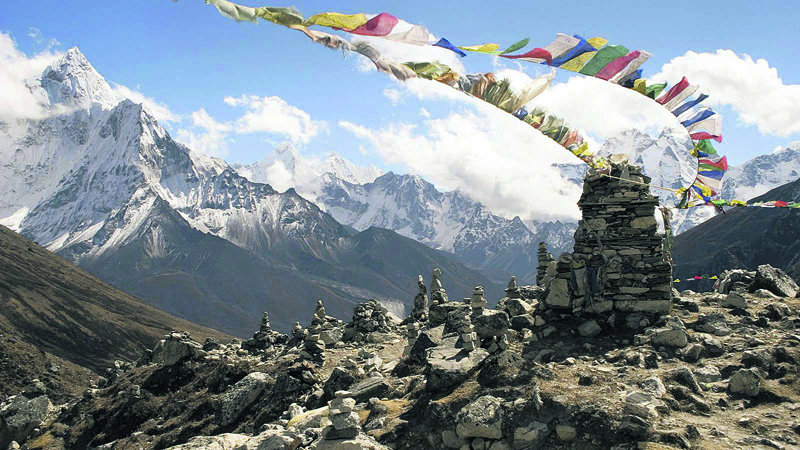
I cried when I reached Langtang, but the tears were not for the beauty that surrounded me but for the fear that I might die. The path was really steep as it was eroded by landside that had occurred in the massive earthquake of 2015. The road was a pile of small rocks. I took a deep breath and took a hesitant step forward. My trembling legs couldn’t get a firm grip and I even slipped a little.
Never in my life had I felt so helpless. The fact that I had no control over my own feet was the scariest thing ever. My whole body was shaking. I wanted someone or something to hold on to and my friend was right behind me but I was too scared to speak. I felt a tiny movement would send me plummeting down to the waterfall that was flowing in its full force.
Langtang trek was a big deal for me because it was my first real trek. I had heard my friends discuss safety measures and saw them research about it but till I went on the trek I didn’t know how tough you need to be, both physically and mentally. I also realized that no amount of preparation can ready you for what you will experience. Despite the hardships I had to endure on the trail, one thing that kept me going was the advice my father gave me before I left: Don’t compete with anyone, especially not with nature. Know your own pace and focus on your goal of reaching the destination without much strain and stress on your mind and body. Enjoy every moment and stop and stare at beautiful things along the way.
Why Langtang?
Langtang valley trek is the nearest Himalayan trek from Kathmandu. The scenery here is spectacular and the trek more adventurous as the area is not yet commercialized and has thus retained its raw beauty. The most accessible of all the trekking regions, it’s well suited to one to two week itineraries.
It is best to visit Lantang in October/November or March/May. While it is possible to trek in winter, chances of snow are higher and passes may be closed, particularly during late winter. The summer/monsoon period is generally unsuitable for trekking as the trails are slippery, leeches abundant and the mountain views unpredictable. It can be a rewarding time, however, if you are prepared to tolerate these drawbacks, as the wild flowers are at their best this time of the year and there are fewer tourists on the trails making interacting with the locals easier.
Being in Langtang feels like you have traveled to various landscapes as you witness magnificent snow-capped Himalayas to barren eroded hills. The many waterfalls give you access to spring water. The swinging bridges connecting two tall hills with Buddhist sacred flags fluttering in the wind leave you soothed. The dense green forest with extreme high and low slopes challenges the trekkers whereas plain grassland with cattle gazing on them is a sight to behold.
The weather is mild and generally dry, making the walking conditions good. The spring season is good for wild flowers, particularly the rhododendrons, while the autumn season generally gives the best mountain views, as the air at this time is crystal clear.
As you have to go through dense forests you will come across steep roads and narrow pathways with huge waterfalls following by the trails. When we were there, there was an entire village covered with big eroded stones and rocks and it stretched for about about two to three kilometers. Apparently, this village was buried by a landslide that had occurred post the massive earthquake of 2015.
The people of this region are mostly Tibetans who came from Kerung in Tibet across the border, changed their ethnicity to Tamang, and settled in Nepal. The culture and traditions of these people are similar to Tibetan across the border but you will also see women proudly carrying their ethnicity wearing Tamang dress and their antique jewelries.
Itinerary
Day 1: Drive to Syabru Besi (1,462m) – 8 hours Bag packed with minimum of clothes, most with food items and a walking stick, early in the morning we drove from Kathmandu to Syabru Besi, Rasuwa. Driving through foothills and ridgeline vistas to Syabru Besi passing Dhunche, we got a glimpse of Ganesh Himal while driving along the Trishuli River. Terraced green hills and lush forests make the drive very pleasurable. Parts of the roads were bumpy as they were under construction.
Day 2: Trek to Lama Hotel (2,500m) – 5 hours
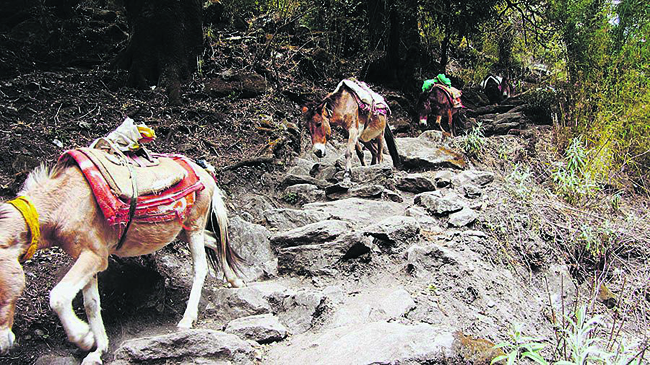 The first part of the trail crosses through the Bhote Koshi river and follows the Langtang khola. This trail gradually ascends up to Bamboo (1,960m) passing rugged paths. Afterwards, your trek climbs gently to Rimche (2,400m) through Bamboo which lies at the bank of Langtang khola. You can have lunch at a place you like and at the end your trail is the Lama Hotel where you can have a pleasurable stay. En route you can see red pandas, monkeys and bears if you are lucky.
The first part of the trail crosses through the Bhote Koshi river and follows the Langtang khola. This trail gradually ascends up to Bamboo (1,960m) passing rugged paths. Afterwards, your trek climbs gently to Rimche (2,400m) through Bamboo which lies at the bank of Langtang khola. You can have lunch at a place you like and at the end your trail is the Lama Hotel where you can have a pleasurable stay. En route you can see red pandas, monkeys and bears if you are lucky.
Day 3: Trek to the Langtang village (3,307m) – 5 hours
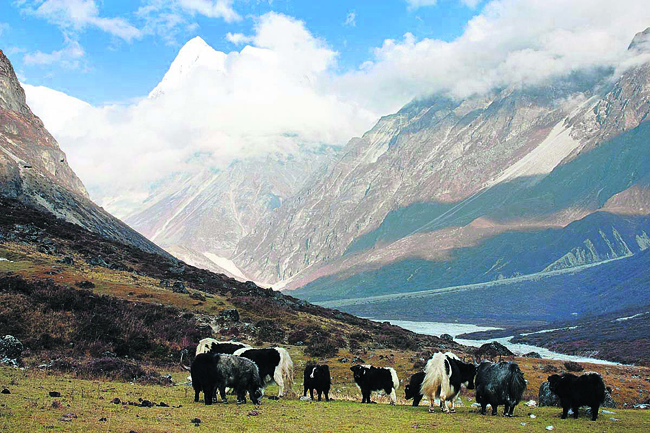 Trek route follows Gumanechok at Ghoda Tabela which literally means the horse stable. After this the trail climbs gradually to the beautiful valley where you can see plenty of Yaks. Langtang is a typical village and one of the oldest along this trekking route. The views of the mountains are spectacular and become more imposing as you progress.
Trek route follows Gumanechok at Ghoda Tabela which literally means the horse stable. After this the trail climbs gradually to the beautiful valley where you can see plenty of Yaks. Langtang is a typical village and one of the oldest along this trekking route. The views of the mountains are spectacular and become more imposing as you progress.
Day 4: Trek to Kyanjin Gompa (3,798m) – 4 hours
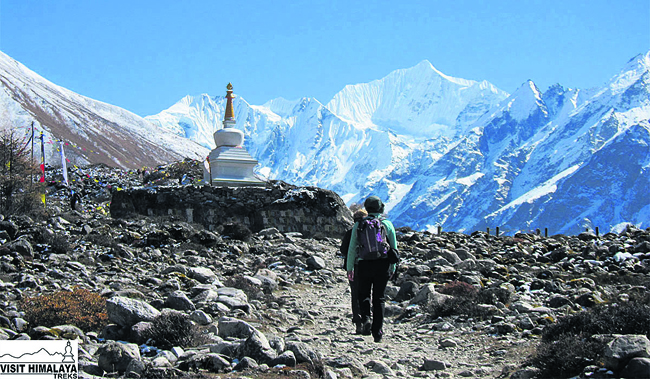 On the fourth day, it’s a shorter walk but it’s adequate for acclimatizing. There are some interesting things to explore, especially the famous cheese factory – don’t forget to try some fresh locally produced cheese. This is the spot from where you can explore the valley and climbs several small peaks.
On the fourth day, it’s a shorter walk but it’s adequate for acclimatizing. There are some interesting things to explore, especially the famous cheese factory – don’t forget to try some fresh locally produced cheese. This is the spot from where you can explore the valley and climbs several small peaks.
Day 5: Kyanjin Gompa exploration day
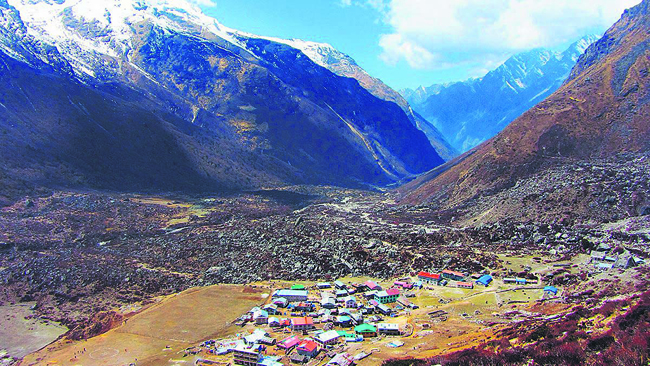 On the fifth day, we rested and explored the area. You can visit the monastery and the cheese factory, walk up the moraine to see the spectacular ice faces and tumbling glaciers of Langtang Lirung or ascend Kyangjin Ri (4,350m) which is the highest point of this trek, directly behind the village, for a breathtaking panorama of the Langtang peaks.
On the fifth day, we rested and explored the area. You can visit the monastery and the cheese factory, walk up the moraine to see the spectacular ice faces and tumbling glaciers of Langtang Lirung or ascend Kyangjin Ri (4,350m) which is the highest point of this trek, directly behind the village, for a breathtaking panorama of the Langtang peaks.
Day 6: Trek back to Lama Hotel (2,500m) – 5.5 hours Rejoin the trail to Lama Hotel.
Day 7: Trek to Sybru Bensi (1, 462m) – 5 hours
Leaving the mountains behind us our descent takes us to the Sybru Bensi where our trek started a week earlier.
Day 8: Drive back to Kathmandu – 8 hours
After breakfast, we drive back to Kathmandu from Sybru Bensi which will take around nice hours heading towards our homes with feeling of accomplishment and loads of memories to cherish.
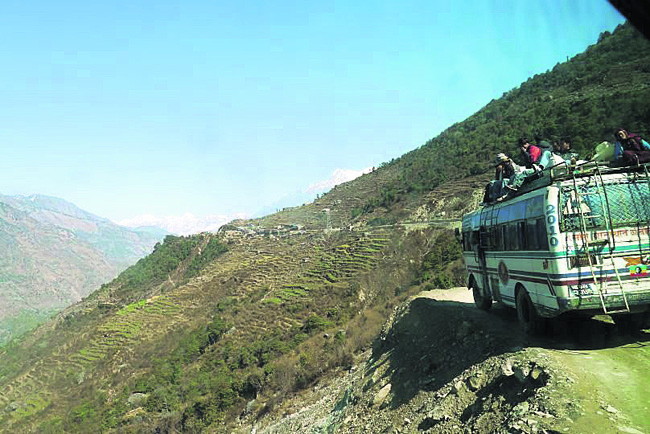
You May Like This

Cheese production diminishing in Langtang
RASUWA, Aug 2: The production of cheese has been decreasing at the Cheese production center in Gosainkunda rural municipality-4 of... Read More...

Langtang featured in NYT's '52 places to go' list
KATHMANDU, Jan 6: Nepal's Langtang Region has been featured in The New York Times-Travel '52 places to go in 2017' list. Read More...
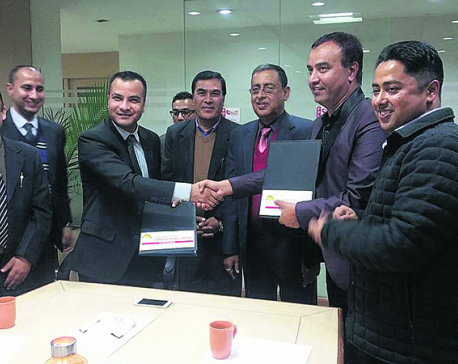
Sunrise-led consortium to finance Langtang Khola Hydropower Project
KATHMANDU, Dec 15: A consortium of banks led by Sunrise Bank Ltd have agreed to finance Langtang Khola Hydropower Project. ... Read More...




Just In
- Govt receives 1,658 proposals for startup loans; Minimum of 50 points required for eligibility
- Unified Socialist leader Sodari appointed Sudurpaschim CM
- One Nepali dies in UAE flood
- Madhesh Province CM Yadav expands cabinet
- 12-hour OPD service at Damauli Hospital from Thursday
- Lawmaker Dr Sharma provides Rs 2 million to children's hospital
- BFIs' lending to private sector increases by only 4.3 percent to Rs 5.087 trillion in first eight months of current FY
- NEPSE nosedives 19.56 points; daily turnover falls to Rs 2.09 billion















Leave A Comment